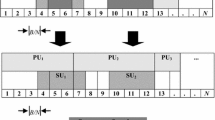Abstract
In cognitive radio networks (CRNs), hybrid overlay and underlay sharing transmission mode is an effective technique to improve the efficiency of radio spectrum. Unlike existing works in literatures where only one secondary user (SU) uses both overlay and underlay mode, the different transmission modes should dynamically be allocated to different SUs according to their different quality of services (QoS) to achieve the maximal efficiency of radio spectrum. However, dynamic sharing mode allocation for heterogeneous services is still a great challenge in CNRs. In this paper, we propose a new resource allocation method based on dynamic allocation hybrid sharing transmission mode of overlay and underlay (Dy-HySOU) to obtain extra spectrum resource for SUs without interfering with the primary users. We formulate the Dy-HySOU resource allocation problem as a mixed-integer programming to optimize the total system throughput with simultaneous heterogeneous QoS guarantee. To decrease the algorithm complexity, we divide the problem into two sub-problems: subchannel allocation and power allocation. Cutset is used to achieve the optimal subchannel allocation, and the optimal power allocation is obtained by Lagrangian dual function decomposition and subgradient algorithm. Simulation results show that the proposed algorithm further improves spectrum utilization with simultaneous fairness guarantee, and the achieved Dy-HySOU diversity gain is satisfying.







Similar content being viewed by others
References
MitolaIII, J. (2000). Cognitive radio: An integrated agent architecture for software defined radio. Ph.D Thesis, KTH Royal Institute of Technology, Stockholm, Sweden.
MitolaIII, J., & Maguire, G. Q, Jr. (1999). Cognitive radio: Making software radios more personal. IEEE Personal Communications, 6(4), 13–18.
Haykin, S. (2005). Cognitive radio: Brain-empowered wireless communications. IEEE Journal of Selected Areas in Communications, 23(2), 201–220.
Zhang, Y., & Leung, C. (2009). Cross-layer resource allocation for mixed services in multiuser OFDM-based cognitive radio systems. IEEE Transactions on Vehicular Technology, 58(8), 4605–4618.
Srinivasa, A., & Jafar, S. A. (2007). The throughput potential of cognitive radio: A theoretical perspective. IEEE Communication Magazine, 45(5), 73–79.
Bansal, G., Duval, O. & Gagnon, F. (2010). Joint overlay and underlay power allocation scheme for OFDM-based cognitive radio systems. In Vehicular technology conference, 2010 IEEE 71st (pp. 1–5).
Zou, J., Xiong, H., Wang, D., & Chen, C. W. (2013). Optimal power allocation for hybrid overlay/underlay spectrum sharing in multiband cognitive radio networks. IEEE Transactions on Vehicular Technology, 62(4), 1827–1837.
Oh, J., & Choi, W. (2010). A hybrid cognitive radio system: A combination of underlay and overlay approaches. In Vehicular technology conference fall, 2010 IEEE 72nd (pp. 1–5).
Senthuran, S., Anpalagan, A., & Das, O. (2012). Throughput analysis of opportunistic access strategies in hybrid underlay–overlay cognitive radio networks. IEEE Transactions on Wireless Communications, 11(6), 2024–2035.
Chakravarthy, V., Li, X., Zhou, R., Wu, Z., & Temple, M. (2009). A novel hybrid overlay/underlay cognitive radio waveform in frequency selective fading channels. In Proceedings of the 4th international conference on Crowncom 2009.
Wang, S., Huang, F., & Wang, C. (2013). Adaptive proportional fairness resource allocation for OFDM-based cognitive radio networks. Wireless Networks, 19, 273–284.
Soon-Ghee, C., & Gildsmith, A. (1997). Variable-rate variable-power MQAM for fading channels. IEEE Transactions on Communications, 45(10), 1218–1230.
Lee, W.-Y. & Akyildiz, I. F. (2008). Joint spectrum and power allocation for inter-cell spectrum sharing in cognitive radio networks. In New frontiers in dynamic spectrum access networks, 2008. DySPAN 2008. 3rd IEEE Symposium (pp. 14–17).
Shen, Z., Andrews, J. G., & Evans, B. L. (2005). Adaptive resource allocation in multiuser OFDM systems with proportional rate constraints. IEEE Transactions on Wireless Communications, 4(6), 2726–2737.
Bollobas, B. (1998). Modern graph theory. New York: Springer.
Lawler, E. L. (1986). Combinatorial optimization: Network and matroids. New York: Holt Rienhart and Winston.
Yu, W., & Lui, R. (2006). Dual methods for nonconvex spectrum optimization of multicarrier systems. IEEE Transactions on Communications, 54(7), 1310–1322.
Kang, X., Garg, H. K., Liang, Y.-C., & Zhang, R. (2010). Optimal power allocation for OFDM-based cognitive radio with new primary transmission protection criteria. IEEE Transactions on Wireless Communications, 9(6), 2066–2075.
Boyd, S., & Vandenberghe, L. (2004). Convex optimization. Cambridge, UK: Cambridge University Press.
Acknowledgments
This work is supported by National Natural Science Foundation of China (No. 61272506).
Author information
Authors and Affiliations
Corresponding author
Rights and permissions
About this article
Cite this article
Chen, Y., Lei, Q. & Yuan, X. Resource allocation based on dynamic hybrid overlay/underlay for heterogeneous services of cognitive radio networks. Wireless Pers Commun 79, 1647–1664 (2014). https://doi.org/10.1007/s11277-014-1950-5
Published:
Issue Date:
DOI: https://doi.org/10.1007/s11277-014-1950-5




